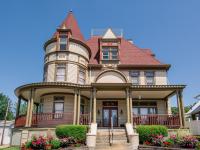You are here
Rediscover Frank Lloyd Wright
Whether you’re a devotee of or merely acquainted with Frank Lloyd Wright—who some consider “the greatest American architect of all time”—you probably haven’t explored the full range of this avant-garde craftsman and innovator. Southern Pennsylvania is the region where his most well-known structures, as well his architectural philosophy, came into the public eye. While some of his work was completed nearly a century ago, for many of us it may be time to rediscover the originality of Frank Lloyd Wright and his Usonian—or New World—designs, which creatively incorporate local materials, natural heating and cooling, and an organic linkage of outdoor and indoor space.
The iconic Fallingwater, a vacation home designed for department store magnate Edward Kaufmann Sr. and built atop rather than across from a portion of waterfall on the Youghiogheny River, isn’t deemed Wright’s masterwork for no reason. In keeping with Wright’s philosophy, the ambitious design utilizes the natural landscape and locally-sourced materials and laborers. In a feat of engineering, the entire structure is anchored to one sandstone column at the center of the house and relies on the stream as its source of natural air conditioning. Unsurprisingly, the house was featured on the cover of Time in 1938, wherein the house was called Wright’s “most beautiful job.” It’s also on the Smithsonian’s “Life List of 28 Places to See Before You Die”—so be sure to cross this off your bucket list sooner rather than later!
Kentuck Knob, one of Wright’s last designs, is a 2,300 square foot one-story home commissioned by the Hagan family which seamlessly merges with Chestnut Ridge, the western edge of the Allegheny Mountains. Some of the most notable features of the home include its use of red cypress, its hexagonal honeycomb skylights, and its low-lying green copper roof overlaying natural stone walls. Situated only four miles from Fallingwater, this house is a must-see add-on for anyone making the trip to Wright’s masterpiece.
The Beth Sholom Synagogue, which was completed shortly after Wright’s death in 1959, invokes the cupped hands of God holding congregants with its pyramidal, tripod roof made of suspended steel and sanded white glass. This National Historic Landmark utilizes white translucent materials on the exterior to bathe the interior space in warm light—the effect of the abundance of natural light paradoxically creates an almost otherworldly glow within the synagogue. Despite its current use as a religious house of worship, this space is open to the public and hosts guided tours.
The Duncan House is a product of Wright’s collaboration with the Marshall Erdman Company, which allowed for Wright’s architecture to be accessible to less wealthy clientele. Originally built in Wisconsin, the home was moved to Pennsylvania’s Polymath Park (a section of woodland containing three other homes built by Wright’s proteges) and exemplifies his natural, Usonian style. The Duncan House is available to book for a unique overnight experience, where the Frank Lloyd Wright lover can truly experience the changed speed of life from within one of Wright’s homes.

